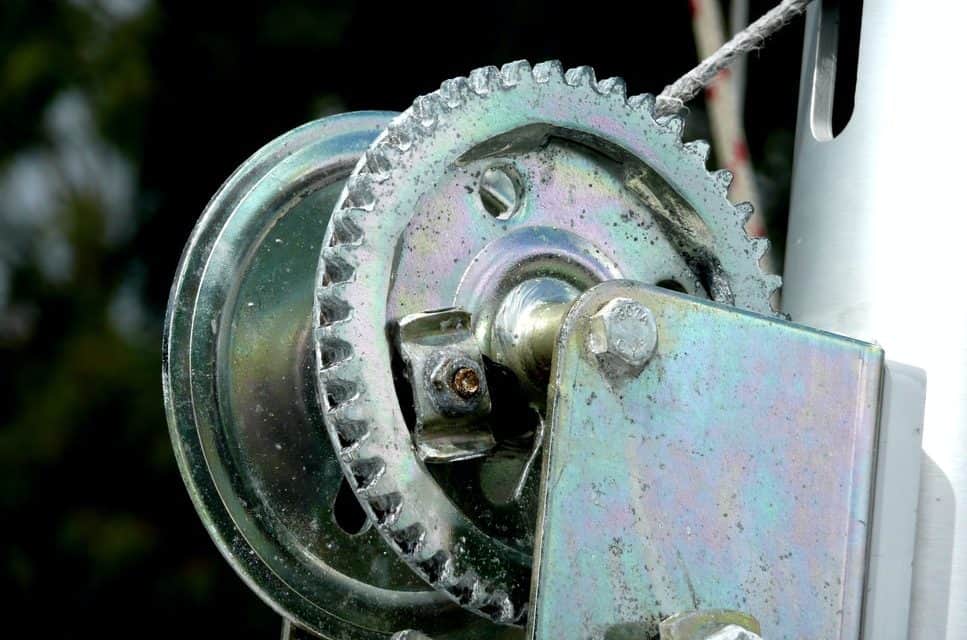An efficient boat trailer winch makes your time on the ramp easier. It’s a heavy-duty piece of gear expected to hold and pull the weight of a boat, which is no easy task.
A good trailer winch gets the job done without complication. A bad one sets you up for headaches and potential danger.
To save you the time and effort of sorting through all the winch options out there, check out our 5 best picks! We’ve also included a comprehensive buyers guide to help you understand the factors to consider when making your decision, as well as some maintenance and safety tips.
Types of Boat Trailer Winches
> Manual trailer winches
A manual boat trailer winch is a mechanism installed on the forward part of a trailer that manually pulls the boat from the water onto the trailer. The boater uses a handle and ratchet system to roll a cable or strap attached to the boat onto the winch drum. As the cable rolls up, the boat pulls onto the trailer.
> Electric trailer winches
An electric boat trailer winch is a mechanism installed on the forward part of a trailer that mechanically pulls the boat from the water onto the trailer. The boater operates buttons to control an electric-powered DC motor which pulls a cable or strap attached to the boat onto the winch drum. As the cable rolls up, the boat pulls onto the trailer.
BEST TRAILER WINCHES – QUICK SUMMARY
[#1] BEST MANUAL WIRE CABLE WINCH: |
| ||
[#2] BEST MANUAL NYLON STRAP WINCH: OPENROAD 3500LBS HAND WINCH |
| ||
[#3] BEST ELECTRIC WIRE CABLE WINCH: MEGAFLINT TRAILER WINCH |
| ||
[#4] BEST ELECTRIC NYLON STRAP WINCH: GOLDENROD ELECTRIC TRAILER WINCH |
| ||
[#5] BEST BUDGET WINCH: SOB 600LBS CAPACITY HEAVY DUTY HAND WINCH |
|
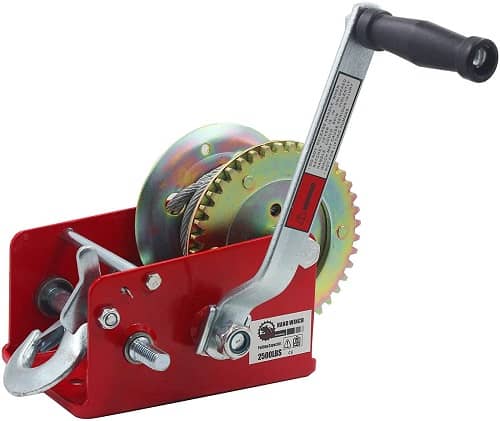
For those who prefer the strength and reliability of a manually operated winch with a steel cable, the OPENROAD 2500lbs hand winch could be what you’re looking for.
It has a cranking capacity of 2500 pounds, capable of pulling a 7500-pound boat. This is less than our other top manual winch choice but should cover a majority of boat owners. This is thanks in part to the corrosion-resistant heat-treated, carbon steel gears and shaft. The quality of its construction also increases its durability and longevity.
The steel cable is 32.8 feet long and is reliable under a heavy load. However, many boaters, especially those who primarily use their boats in saltwater, find that the steel cables will rust and fray over time and use.
To make pulling your boat more convenient, the gear ratio, which affects crank speed, can be adjusted to either a 4:1 or 8:1 ratio. Also, it has a 2-way ratchet system, giving you the ability to crank both forward and reverse.
Although this model has less cranking capacity than the other manual model on our list, it’s a reliable winch and a cheaper alternative to an electric winch.
pros
- 2500 pound cranking capacity (7500 pound boats)
- Carbon steel gears and shaft
- Reliable steel cable
- Adjustable gear ratio
- 2-way ratchet system
cons
- Cable will fray and rust over time and use
Less cranking capacity than the other manual winch
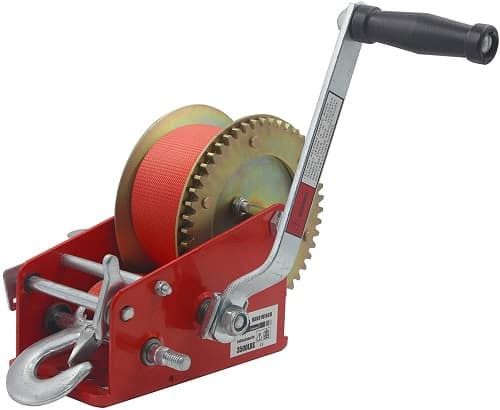
This winch is very similar to the previous manual OPENROAD model, but instead of a steel cable, it employs a heavy-duty nylon strap. It has a 3500 pound cranking capacity, which can pull up to a 10,500 pound boat. This makes it the winch with the highest cranking capacity on our list.
The 32 feet of nylon strap can handle a heavy load. However, it can’t compare to the strength and reliability of a steel cable. It’ll wear over time, and its strength will diminish. You’ll need to replace it more often than the steel cable. So, you’ll need to keep a watchful eye for deterioration.
The nylon straps are easier to work with. You can grab hold of it without worrying about frayed metal cutting your hand as with a steel cable.
For the most part, this is a reliable winch. However, under heavier loads, the gears and teeth could be the first components to fail.
If you don’t mind putting in the physical cranking effort, this model is significantly cheaper than an electric winch and has an even higher weight capacity.
pros
- Highest cranking capacity at 3500 pounds
- Straps won’t cut your hand
- High-strength anti-slip and wear-resistant strap
- Less expensive than electric winches
cons
- Potential for gear slipping and teeth breaking
- Requires manual effort
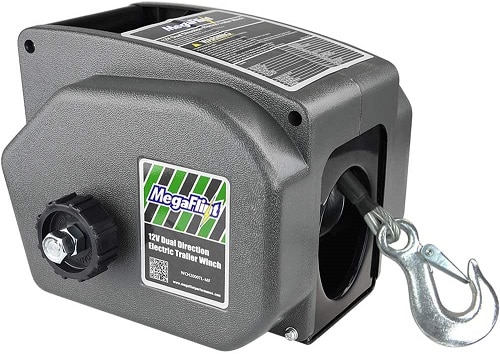
If you’re looking for the reliability and longevity of a steel cable winch, with the convenience of an electric pulling system, the Megaflint trailer winch is an option worth considering.
With a 2000 pound cranking capacity, it’s capable of handling a 6000 pound boat. For those with small to mid-size boats, this capacity should be sufficient in typical pulling situations. That said, aside from our budget option, this is the winch with the lowest capacity on our list. So, it may not cut it for bigger boats or in more demanding situations.
The steel cable is galvanized to prevent corrosion, but even the most resilient metal cable will start to corrode and fray if not properly maintained. It also can roll onto the winch drum in a disorganized way, which can make it a pain to work with.
The winch has a power-in, power-out mode for controlled pulling and releasing. It also has well as a freewheel mode for quick release. To further increase control, it has both a dynamic and mechanical friction brake.
Although it has less cranking capacity than the electric nylon strap winch on our list, it comes with a corded remote and is more budget-friendly.
pros
- Reliable, galvanized steel cable
- Power-in, Power-out, and Freewheel operation.
- Dynamic and mechanical friction brake
- Cheaper than the electric nylon strap winch
- Corded remote control
cons
- Less cranking capacity at 2000 pounds
- Steel cable can spool incorrectly and deteriorate if not maintained
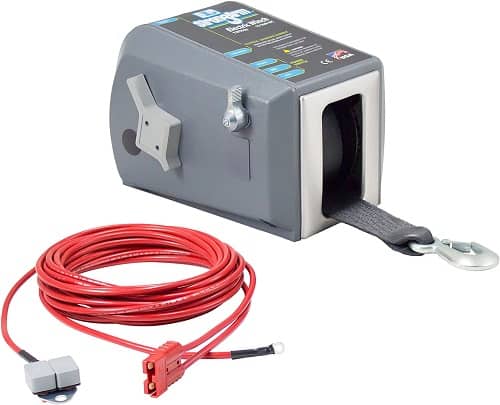
The Goldenrod electric trailer winch combines the convenience of an electric winch with a more user-friendly nylon strap.
It has the highest cranking capacity of both electric winches on our list at 3000 pounds. It’s second in capacity only to the OPENROADS manual nylon strap model. The upside here is that, although it comes with a manual crank handle option, it’s not a necessity to crank your boat physically.
The nylon strap on this winch is far easier to work with than a steel cable. It rolls back on the drum correctly more consistently, and you can handle it without risk of cutting yourself on frayed metal.
Unlike the Megaflint electric winch, this model lacks a remote control. This means you’ll need to operate the winch while standing beside the unit. This can be an inconvenience, especially for those pulling boats on their own. It also has a more limited electric crank time of 4 minutes, which is 2-4 minutes less than the Megaflint winch.
However, it’s similar to the Megaflint in its use of both dynamic and mechanical friction brakes, as well as its power in, power out, and freewheel operation modes.
pros
- Highest electric cranking capacity at 3000 pounds cranking capacity
- Physically easier than hand cranking
- Manual crank handle option
- Power in, power out, freewheel operation modes
- Dynamic and mechanical friction brakes
cons
- No remote control operation
- 4-minute electric crank limit
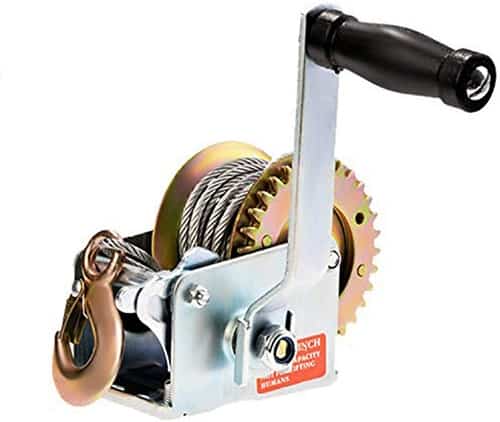
If the budget is tight and your pulling needs are modest, the SoB hand winch could be a good option for you.
It has a 600 pound cranking capacity, capable of pulling a boat around 1800 pounds. This makes it the winch with the least cranking capacity on our list. That said, the winch itself is surprisingly well made and reliable as long as you keep within the weight capacity.
To further increase reliability, SoB has opted to use a steel cable. Although there are handling issues once the metal starts to fray or roll back on the drum incorrectly, metal is more dependable than nylon straps.
The convenient 2-way ratchet system allows you to adjust between forward and reverse ratcheting. However, compared to the other manual winches on this list with dual gear speeds, this model has only a single-speed gear ratio of 3.1/1.
Electric winches are easier and more convenient, however, they’re far more challenging to install than this manual unit. Without the need to run wires, the setup is just a simple process of bolting it onto the trailer.
Overall, this is a reliable, budget-friendly option that will get the job done without breaking the bank.
pros
- Budget-friendly
- Forward and reverse ratcheting option
- Reliable steel cable
- Easy to install
- Well made and reliable considering the price
cons
- Lowest cranking capacity at 600 pounds
- Single-speed gear ratio of 3.1/1
- Handling issues with steel cable
Buyers Guide: How To Choose a Boat Trailer Winch
Every boat owner has different needs when it comes to boat trailer winches. So, let’s discuss the factors you should be thinking about to help you decide which winch is right for you.
MANUAL OR ELECTRIC
There are two types of winches–manual and electric. Although there are some obvious differences between the two, some less apparent factors should be considered before you decide which one is right for you.
PHYSICAL EFFORT
Let’s start with the obvious. A manual winch requires physical effort to pull your boat while an electric winch only requires that you operate a button. Depending on your boat’s weight, your trailer, and the angle you’re pulling, physically cranking the boat onto a trailer can be demanding on your body. After a long day out on the boat, an electric winch provides a level of convenience some boaters will greatly appreciate.
However, you will pay for this convenience. Electric winches can be significantly more expensive than manual cranks, potentially even by a few hundred dollars. On top of the initial expense, you also have the reality of higher maintenance costs and headaches due to the more complex design.
RELIABILITY
Electrical systems are prone to malfunction over time, especially when continuously exposed to salt water and air. Manual winches, on the other hand, are relatively simple mechanisms with less complicated moving parts. They still require routine maintenance, but they’re generally more dependable than electric winches. This is something to keep in mind if reliability is a high priority for you.
INSTALLATION
The wiring system electrical winches require also presents an inconvenience when it comes to installation. Where manual winches are relatively simple, only requiring a few bolts to mount, you’ll need to run wire between the unit and a power source on your vehicle for an electric winch. It’s not an incredibly difficult process, but it can add a few hours to the setup, especially for those without electrical/mechanical experience.
ELECTRICAL CRANK TIME LIMIT
Another complication with electrical winches is their crank time limits. Manufacturers of these winches set a time limit on how long you should use the electrical function continuously. If you’re pulling over a longer distance, or have an extended pull time due to a heavy boat or steep ramp, you could hit your limit before the pull is complete. When this happens, you’ll have to wait a few minutes until you can start pulling again. This can range from slightly annoying to potentially dangerous, depending on your pulling situation.
The nice thing about electric winches is that, even though they present the possibility for complications, specifically due to their electrical system, they almost all have a backup manual hand crank option if electric functionality fails.
NYLON STRAP OR WIRE CABLE
There’s no definitive answer to whether a nylon strap or a wire cable is ‘better’. However, there are advantages and disadvantages to both that will appeal to the nature and experience of different boat owners.
STRENGTH
Let’s discuss some advantages of wire cable. People prefer wire cable, specifically steel wire cable, because it maintains its reliability under a heavy load longer into its lifespan. As long as the wire cable isn’t frayed to bits, you’ll have to worry more about the winch failing than the cable snapping.
Nylon straps, on the other hand, start strong but eventually wear down and lose strength. This process happens much faster than the corrosion and fraying breakdown experienced by wire cables. It’s also much more difficult to identify when the nylon has weakened to a potentially dangerous point.
Although they’re relatively cheap, you’ll have to replace a nylon strap more frequently. You’ll also have to carefully and continuously monitor its integrity, specifically at the stitching, to ensure it’s capable of handling the pull.
HANDLING
The big advantage of a nylon strap is that it’s easier and, in some ways, safer to handle than wire cable. Wire cables require routine maintenance and care to prevent fraying, which can become a bit time-consuming. However, no matter how well you maintain wire cable, it will eventually fray, exposing sharp pieces of metal wire throughout the line. When you inevitably need to handle the cable, you can easily cut your hands on these frayed bits of metal wire.
This is where nylon straps show their greatest value. You can handle them without the risk of cutting your hands. Plus, they roll back onto the winch neatly compared to wire cable, which can become a hassle to roll back onto the winch.
WHO ARE THEY MEANT FOR?
When it comes down to it, nylon straps are more user-friendly but less reliable. They’ll meet the needs of more casual boaters who don’t typically place extreme demands on their winches.
Wire cables are preferred by industry professionals and those who prioritize consistent strength and reliability over the long run. They’ll need to be properly maintained, and you may want a set of work gloves while handling it, but you’ll get added peace of mind for your efforts.
Trailer winch CRANKING CAPACITY
The cranking capacity of a winch refers to the pulling power of the winch. A common misconception is that the advertised cranking weight capacity of a winch is the maximum boat weight it can pull, which is not the case.
Boat trailer winch manufacturers typically advertise a 3:1 boat weight to cranking capacity ratio. For example, a winch with a cranking capacity of 2000 pounds could pull a boat weighing up to 6000 pounds.
The tricky thing is that the 3:1 ratio is not a precise formula. The boat weight a winch is capable of pulling is affected by the boat ramp’s steepness, whether your trailer has rollers or wood blocks, the distance you need to pull the boat, and the weather/current conditions.
If you’re pulling at a steep angle but have a trailer with rollers and only need to pull a short distance in fair conditions, the ratio might be closer to 2:1.
If you’re pulling at a steep angle, have a trailer with wood blocks, and are pulling over a long distance in rough conditions, the ratio could be around 1:1.
The 3:1 ratio manufacturers use in their product descriptions assumes you have rollers and are pulling at a moderate angle and distance in fair conditions. So, keep that in mind when considering your options.
Trailer winch GEAR RATIO
The gear ratio of a winch will determine the speed and strength the strap or cable is pulled in at. Some winches have multiple gear ratios, which allows you to adjust the speed based on the weight and preferred cranking resistance, while others only have one speed.
Lower gear ratios, such as 3:1 or 4:1, are best suited for lighter boats. Higher gear ratios can reach higher than 800:1 and make it easier to crank heavier boats. The desired or necessary gear ratio can also be affected by the same factors which affect the maximum boat weight of cranking capacity, including steepness of the ramp, trailer resistance (wheels or wooden blocks), distance pulled, and weather/current conditions.
It’s advantageous to have a winch with multiple gear ratios to adjust strength, speed, and resistance based on the situation. However, these winches will typically cost more than those with single gear ratios.
While you may be able to get away with a single gear ratio for smaller, lighter boats, it’s highly recommended that you have a winch with multiple gear ratios for larger, heavier boats.
How to Service & Maintain a Boat Trailer Winch
Routine maintenance
To keep your winch running smoothly, there are a few maintenance and upkeep best practices to observe.
- Rinse the winch and fully extended cable/strap with fresh water as soon as possible after every use to prevent corrosion and deterioration
- After rinsing the fully extended cable/strap, allow it to dry before rolling it back up to prevent corrosion of the drum
- With an electric winch, be sure the cable/strap is pulled tight when rolling it back up without weight to prevent tangles
- Before, during, and after every use, examine the cable/strap for signs of deterioration, fraying, and corrosion
- With metal cables, apply lubrication to the length of the cable periodically or as often as needed to prevent abrasion and facilitate a smooth roll
- Remove rust with steel wool or a wire brush and rust remover
Servicing a trailer winch
Even if you are diligent about cleaning and maintaining your winch on a frequent basis, you should still do a full service of the winch 1-2 times per year depending on how much you use it. This consists of taking apart the winch, replacing any worn or broken parts, cleaning and lubricating all intact parts, and then reassembling. This will help the winch run more efficiently, as well as reduce the risk of failure while under load.
Here are the steps to follow for servicing your winch:
- You’ll need tools, so be sure to have allen wrenches or an adjustable wrench handy
- Unassemble the winch by consulting the service manual. If you don’t have the physical manual, search online for a digital copy
- As you are unassembling the winch, assess each part for damage or wear that could compromise its integrity. When in doubt, replace the part
- Using a degreaser or diesel, clean the drum, bearings, washers, pawls, springs, pads, and winch base.
- Dry thoroughly with a clean cloth
- Use light machine oil to lubricate the pawls and bushings. Use winch grease for all other parts
- Once all damaged parts have been replaced, and the remaining parts have been cleaned and lubricated, you can reassemble the winch
Boat Trailer Winch Safety Tips
Always:
- Pay close attention whenever using the winch. Don’t multitask!
- Wear gloves, especially if your winch uses a metal cable
- Pull the boat from the shortest possible distance
- Check your cable/strap for signs of wear before using it
- Use blocks to prevent your vehicle from rolling down the boat ramp while pulling
Never:
- Overload the winch past its cranking capacity
- Stand behind the boat or close to the cable/strap in case it snaps
- Lift a boat out of the water vertically
- Use the winch to secure the trailer to your vehicle. Use dedicated tie-downs
For Electric:
- Be sure to keep your vehicle running when using the winch to prevent killing the battery
- Always connect the winch to a compatible circuit breaker to prevent overheating and damage
- Never run the winch past the run time recommended by the manufacturers
Frequently asked questions
How big of a winch do I need for my boat?
The winch size you need for your boat depends on a few factors.
- The weight of your boat
- Whether your trailer has rollers or wooden blocks
- The steepness of the launch ramp
- The pulling distance
- The weather and current conditions
The more your boat weighs, the steeper the ramp, the farther you pull, and the worse the weather/current condition, the bigger the winch needs to be.
Your first step is determining how these variables relate to your situation. If you always launch your boat at the same ramp, it should be pretty straightforward. If you travel around with your boat and often launch at unfamiliar ramps, you may want to estimate on the conservative side to give yourself the widest range.
Once you’ve determined the variables unique to your needs, you can compare them to the cranking capacity of the winches you’re considering. The cranking capacity refers to the winch’s pulling power and is the best specification to identify the appropriate size winch for your boat.
Boat weight to cranking capacity ratio
A winch with a cranking capacity of 1000 pounds can pull a boat between 1000 and 3000 pounds, which means it has a 1:1, 2:1, or 3:1 boat weight to cranking capacity ratio. The ratio you should use for your boat depends on the other 4 variables–your trailer, ramp steepness, distance pulled, and weather conditions.
Winch manufacturers advertise a 3:1 ratio in their product descriptions because it’s the highest weight the winch can potentially pull. However, this estimate assumes that you’re using rollers, launching from a moderately steep ramp, and pulling a short distance in good weather/current conditions.
A ratio of 1:1 would assume your trailer has wooden blocks, you’re launching from a pretty steep boat ramp, and pulling a long distance with some wind and current.
If your variables are mixed, you could estimate around 2:1. When in doubt, error on the side of safety and take the more conservative estimate. It never hurts to have more cranking capacity, but less could lead to problems.
How do I replace a winch strap?
When your winch strap begins to show signs of fraying or deteriorating, it’s a critical matter of safety to replace it with a new one. Here are the steps you can take to replace your old winch strap.
- Purchase a replacement strap that can hold a load that exceeds the weight of your boat by 20% or more and is close to the same length as your old strap
- Take off the old strap by pulling it out completely and removing the central bolt
- Replace the central bolt with a new one if it’s damaged
- Scrape any rust or corrosion from the winch cage using a wire brush or steel wool and spray a galvanizing coating if necessary
- Place the central bolt into the winch cage and through the sleeve at the end of the strap
- Tighten the bolt, making sure not to over tighten it
- Hold the belt taught and roll it onto the drum
FINAL THOUGHTS
As you can see, there are many factors you’ll need to consider to determine which boat trailer winch is suitable for your needs. There are inevitable compromises in choosing one type over another, but we hope you’re now armed with the knowledge to make an informed decision.
- How to Pick The Best Trolling Motor Battery of 2022 - November 19, 2022
- 5 Best Boat Trailer Winches (Electric & Manual) of 2021 - April 16, 2021
- 5 Best Bilge Pumps For Boating In 2021 - March 29, 2021

